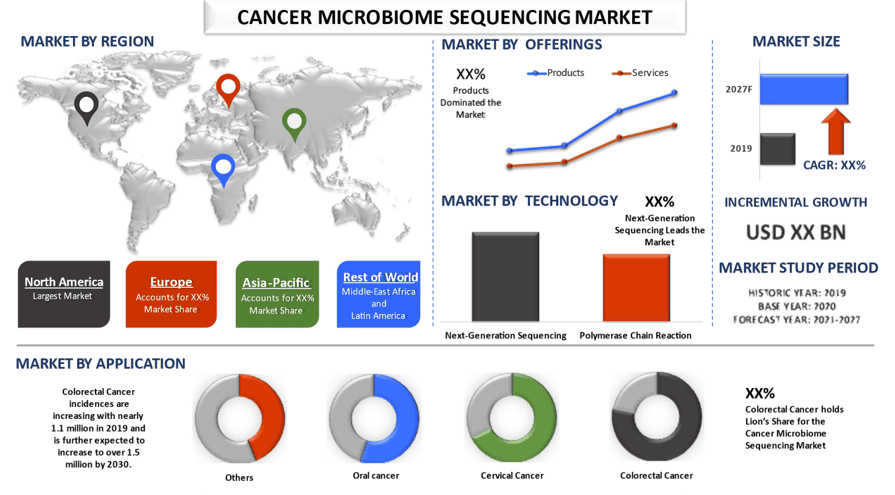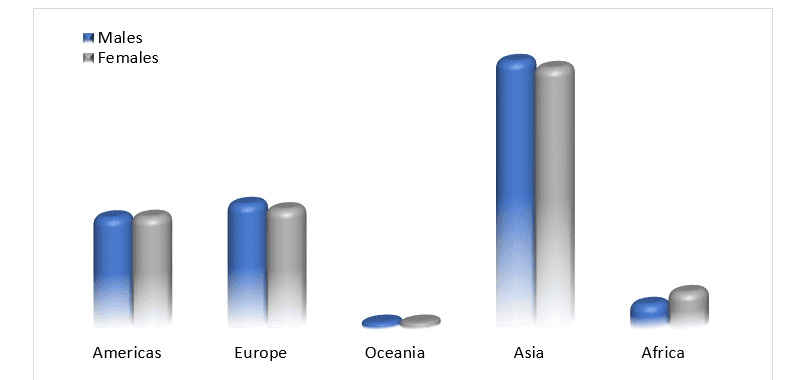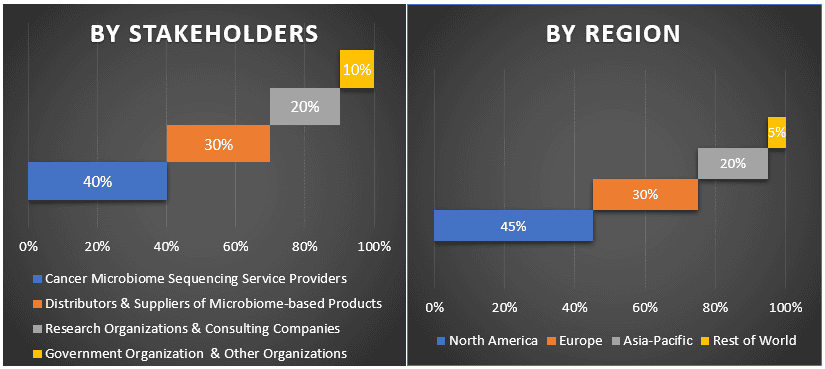- Inicio
- Acerca de nosotros
- Industria
- Servicios
- Leyendo
- Contáctenos
Mercado de secuenciación del microbioma del cáncer: análisis actual y pronóstico (2021-2027)
Énfasis en las Ofertas (Productos, Servicios); Tecnología (Secuenciación de Nueva Generación, Reacción en Cadena de la Polimerasa); Aplicación (Cáncer Colorrectal, Cáncer Cervical, Cáncer Oral, Otros); Usuarios Finales (Institutos Académicos y de Investigación, Empresas Farmacéuticas y Biotecnológicas, Hospitales y Laboratorios de Diagnóstico, Otros); Región y País

SOLICITAR PDF DE MUESTRA GRATUITO
Se prevé que el mercado mundial de secuenciación del microbioma del cáncer crezca con una TCAC elevada de alrededor del 20% durante el período de previsión (2021-2027). El microbioma es la colección de todas las secuencias de genes de una comunidad microbiana en el cuerpo humano que contribuye a la salud humana y al cuerpo. La secuenciación permite la elaboración de perfiles de comunidades microbianas que pueden ser objeto de nuevas estrategias terapéuticas para el cáncer.
El mercado de la secuenciación del microbioma del cáncer ha ido creciendo debido a diversos factores, entre ellos el creciente énfasis en el potencial del microbioma en el campo del cáncer y el aumento de la incidencia del cáncer en todo el mundo. Por ejemplo, el número de casos de cáncer en los EE. UU. aumentará un 49% cada año, de 1.534.500 en 2015 a 2.286.300 en 2050, con el mayor aumento porcentual entre los adultos de ≥75 años, según las predicciones de los CDC. Este aumento exponencial en la prevalencia del cáncer ha creado un revuelo entre las empresas de biotecnología para invertir en el desarrollo de nuevas herramientas de diagnóstico basadas en el microbioma que ofrecerán la detección temprana del cáncer.
Además, la promulgación de alianzas estratégicas entre los agentes de la industria para acelerar la investigación del microbioma es otro factor destacado que está impulsando significativamente el mercado de la secuenciación del microbioma del cáncer a nivel mundial. Por ejemplo, en junio de 2021, Illumina y Microba Life Sciences se asociaron para avanzar en su comprensión del microbioma intestinal humano en la salud y la enfermedad humanas. Las revolucionarias herramientas NGS de Illumina y la plataforma de análisis del microbioma intestinal patentada de alta calidad de Microba generarán los datos metagenómicos precisos que los investigadores necesitan para impulsar los descubrimientos.
Distribución de la incidencia de cáncer en todo el mundo (%), 2020, por género

Thermo Fisher Scientific Inc., CD Genomics, Eurofins Scientific, Illumina, Inc., Prescient Medicine Holdings, Inc., QIAGEN N.V., Micronoma Inc., Oxford Nanopore Technologies, Zymo Research Corporation, OraSure Technologies, Inc., son algunos de los actores destacados que operan en el mercado de la secuenciación del microbioma del cáncer. Estos actores han realizado varias fusiones y adquisiciones junto con asociaciones para facilitar a los clientes los productos de secuenciación del microbioma del cáncer.
Perspectivas presentadas en el informe
“Entre las ofertas, el segmento de productos tiene la mayor cuota”
En función de las ofertas, el mercado de la secuenciación del microbioma del cáncer se divide en productos y servicios. El segmento de productos representó la principal cuota de mercado en 2020 y se estima que exhibirá la TCAC más alta durante la previsión. El segmento de productos se subdivide además en kits y ensayos, y software. El crecimiento de este segmento puede atribuirse al creciente número de procedimientos de secuenciación y al lanzamiento de kits de ensayo y software nuevos y avanzados. Sin embargo, se espera que el segmento de servicios crezca considerablemente durante el período de tiempo proyectado.
“Entre las tecnologías, el segmento de secuenciación de última generación tiene la mayor cuota”
En función de la tecnología, el mercado de la secuenciación del microbioma del cáncer se segmenta en secuenciación de última generación (NGS) y reacción en cadena de la polimerasa. El segmento de secuenciación de última generación ocupó una parte sustancial del mercado de la secuenciación del microbioma del cáncer en 2020 y se espera que crezca considerablemente en los próximos años, ya que la NGS permite a los clínicos analizar varios genes del cáncer simultáneamente. Además, la creciente adopción de la secuenciación de última generación en la oncología clínica para avanzar en el tratamiento personalizado del cáncer también está contribuyendo al crecimiento del segmento.
“Entre las aplicaciones, el segmento del cáncer colorrectal tiene la mayor cuota”
En función de la aplicación, el mercado se fragmenta en cáncer colorrectal, cáncer de cuello uterino, cáncer oral y otros. En 2020, el segmento del cáncer colorrectal acaparó una cuota de mercado considerable y se espera que crezca a una TCAC significativa durante el período de previsión. El crecimiento de este segmento se atribuye al aumento de la incidencia del cáncer colorrectal a nivel mundial. Por ejemplo, según el informe de la Agencia Internacional de Investigación sobre el Cáncer, la incidencia del cáncer de colon fue de casi 1,1 millones en 2019 y se espera que aumente a más de 1,5 millones en 2030.
“Entre los usuarios finales, el segmento de hospitales y laboratorios de diagnóstico tiene la mayor cuota”
En función de los usuarios finales, el mercado se fragmenta en instituciones académicas y de investigación, empresas farmacéuticas y biotecnológicas, hospitales y laboratorios de diagnóstico, y otros. En 2020, el segmento de hospitales y laboratorios de diagnóstico acaparó una cuota de mercado considerable y se espera que crezca a una TCAC significativa durante el período de previsión, ya que la mayoría de las pruebas de secuenciación se realizan en laboratorios para detectar diversas enfermedades. Sin embargo, se espera que el segmento de instituciones académicas y de investigación crezca significativamente en los próximos años.
“América del Norte representa uno de los mayores mercados de secuenciación del microbioma del cáncer”
Para una mejor comprensión de la dinámica del mercado de secuenciación del microbioma del cáncer, se realizó un análisis detallado de diferentes regiones de todo el mundo, incluyendo América del Norte (EE. UU., Canadá y el resto de América del Norte), Europa (Alemania, Francia, España, Reino Unido, Italia y el resto de Europa), Asia-Pacífico (China, India, Australia, Japón y el resto de APAC), el resto del mundo. América del Norte constituye un mercado importante para la industria del mercado de secuenciación del microbioma del cáncer y generó ingresos de USD XX millones en 2020 debido al creciente gasto en atención médica y la presencia de actores de la industria en la región.
Razones para comprar este informe:
- El estudio incluye el dimensionamiento del mercado y el análisis de previsión validado por expertos clave autenticados de la industria
- El informe presenta una revisión rápida del rendimiento general de la industria de un vistazo
- El informe cubre un análisis en profundidad de los pares prominentes de la industria con un enfoque principal en las finanzas comerciales clave, la cartera de productos, las estrategias de expansión y los desarrollos recientes
- Examen detallado de los impulsores, las restricciones, las tendencias clave y las oportunidades que prevalecen en la industria
- El estudio cubre de forma exhaustiva el mercado a través de diferentes segmentos
- Análisis profundo a nivel regional de la industria
Opciones de personalización:
El mercado mundial de secuenciación del microbioma del cáncer se puede personalizar aún más según los requisitos o cualquier otro segmento de mercado. Además de esto, UMI entiende que puede tener sus propias necesidades comerciales, por lo tanto, no dude en conectarse con nosotros para obtener un informe que se adapte completamente a sus requisitos.
Tabla de contenido
El análisis del mercado histórico, la estimación del mercado actual y la previsión del mercado futuro del mercado mundial de secuenciación del microbioma del cáncer fueron los tres pasos principales que se llevaron a cabo para crear y analizar la adopción de la secuenciación del microbioma del cáncer en las principales regiones del mundo. Se llevó a cabo una exhaustiva investigación secundaria para recopilar las cifras históricas del mercado y estimar el tamaño actual del mercado. En segundo lugar, para validar estas perspectivas, se tomaron en consideración numerosos hallazgos y supuestos. Además, también se realizaron exhaustivas entrevistas primarias con expertos de la industria a lo largo de la cadena de valor del mercado mundial de secuenciación del microbioma del cáncer. Tras la suposición y la validación de las cifras del mercado a través de entrevistas primarias, empleamos un enfoque de arriba hacia abajo/de abajo hacia arriba para pronosticar el tamaño completo del mercado. Posteriormente, se adoptaron métodos de desglose del mercado y de triangulación de datos para estimar y analizar el tamaño del mercado de los segmentos y subsegmentos a los que pertenece la industria. La metodología detallada se explica a continuación:
Busque más detalles sobre la metodología de investigación
Análisis del tamaño del mercado histórico
Paso 1: Estudio en profundidad de fuentes secundarias:
Se realizó un estudio secundario detallado para obtener el tamaño del mercado histórico de la secuenciación del microbioma del cáncer a través de fuentes internas de la empresa, como informes anuales y estados financieros, presentaciones de rendimiento, comunicados de prensa, etc., y fuentes externas que incluyen revistas, noticias y artículos, publicaciones gubernamentales, publicaciones de la competencia, informes del sector, bases de datos de terceros y otras publicaciones creíbles.
Paso 2: Segmentación del mercado:
Después de obtener el tamaño del mercado histórico del mercado de secuenciación del microbioma del cáncer, llevamos a cabo un análisis secundario detallado para recopilar información histórica del mercado y compartirla para diferentes segmentos y subsegmentos para las principales regiones. Los principales segmentos incluidos en el informe son ofertas, aplicación, tecnología y usuarios finales. Además, se llevaron a cabo análisis a nivel de país para evaluar la adopción general de la secuenciación del microbioma del cáncer en todo el mundo.
Paso 3: Análisis de factores:
Después de adquirir el tamaño del mercado histórico de diferentes segmentos y subsegmentos, llevamos a cabo un análisis de factores detallado para estimar el tamaño actual del mercado de la secuenciación del microbioma del cáncer. Además, llevamos a cabo un análisis de factores utilizando variables dependientes e independientes, como la creciente prevalencia del cáncer y el aumento del uso de microbiomas en genómica. Se llevó a cabo un análisis exhaustivo de los escenarios de oferta y demanda teniendo en cuenta las principales asociaciones, fusiones y adquisiciones, la expansión empresarial y los lanzamientos de productos en el sector de la secuenciación del microbioma del cáncer en todo el mundo.
Estimación y previsión del tamaño actual del mercado
Tamaño actual del mercado: Basándonos en la información práctica de los 3 pasos anteriores, llegamos al tamaño actual del mercado, los principales actores en el mercado de secuenciación del microbioma del cáncer y las cuotas de mercado de los segmentos. Todos los porcentajes de participación requeridos y los desgloses del mercado se determinaron utilizando el enfoque secundario mencionado anteriormente y se verificaron a través de entrevistas primarias.
Estimación y previsión: Para la estimación y la previsión del mercado, se asignaron ponderaciones a diferentes factores, incluidos los impulsores y las tendencias, las restricciones y las oportunidades disponibles para las partes interesadas. Después de analizar estos factores, se aplicaron técnicas de previsión relevantes, es decir, un enfoque de arriba hacia abajo/de abajo hacia arriba, para llegar a la previsión del mercado alrededor de 2027 para diferentes segmentos y subsegmentos en los principales mercados a nivel mundial. La metodología de investigación adoptada para estimar el tamaño del mercado abarca:
- El tamaño del mercado de la industria, en términos de valor (US$) y la tasa de adopción de la secuenciación del microbioma del cáncer en los principales mercados a nivel nacional
- Todos los porcentajes de participación, divisiones y desgloses de los segmentos y subsegmentos del mercado
- Actores clave en el mercado de secuenciación del microbioma del cáncer en términos de productos ofrecidos. Además, las estrategias de crecimiento adoptadas por estos actores para competir en el mercado de rápido crecimiento
Validación del tamaño y la cuota de mercado
Investigación primaria: Se realizaron entrevistas en profundidad con los líderes de opinión clave (KOL), incluidos los ejecutivos de alto nivel (CXO/VP, jefe de ventas, jefe de marketing, jefe de operaciones y jefe regional, jefe de país, etc.) en las principales regiones. Luego, se resumieron los hallazgos de la investigación primaria y se realizó un análisis estadístico para probar la hipótesis establecida. Las aportaciones de la investigación primaria se consolidaron con los hallazgos secundarios, convirtiendo así la información en información práctica.
División de los participantes primarios en diferentes regiones

Ingeniería de mercado
Se empleó la técnica de triangulación de datos para completar la estimación general del mercado y para llegar a cifras estadísticas precisas de cada segmento y subsegmento del mercado de secuenciación del microbioma del cáncer. Los datos se dividieron en varios segmentos y subsegmentos después de estudiar varios parámetros y tendencias en las áreas de ofertas, aplicaciones, tecnología y usuarios finales del mercado de secuenciación del microbioma del cáncer.
El objetivo principal del estudio del mercado de secuenciación del microbioma del cáncer
Las tendencias actuales y futuras del mercado de secuenciación del microbioma del cáncer se señalaron en el estudio. Los inversores pueden obtener información estratégica para basar su discreción para las inversiones del análisis cualitativo y cuantitativo realizado en el estudio. Las tendencias actuales y futuras del mercado determinaron el atractivo general del mercado a nivel regional, proporcionando una plataforma para que el participante industrial explote el mercado sin explotar para beneficiarse como una ventaja de ser el primero en actuar. Otros objetivos cuantitativos de los estudios incluyen:
- Analizar el tamaño actual y previsto del mercado de secuenciación del microbioma del cáncer en términos de valor (US$). Además, analizar el tamaño actual y previsto del mercado de diferentes segmentos y subsegmentos
- Los segmentos en el estudio incluyen áreas de ofertas, aplicaciones, tecnología y usuarios finales
- Definir y analizar el marco regulatorio para la industria de secuenciación del microbioma del cáncer
- Analizar la cadena de valor involucrada con la presencia de varios intermediarios, junto con el análisis de los comportamientos de los clientes y competidores de la industria
- Analizar el tamaño actual y previsto del mercado del mercado de secuenciación del microbioma del cáncer para la región principal
- Las principales regiones estudiadas en el informe incluyen América del Norte, Europa, Asia-Pacífico y el resto del mundo
- Perfiles de empresas del mercado de secuenciación del microbioma del cáncer y las estrategias de crecimiento adoptadas por los actores del mercado para mantenerse en el mercado de rápido crecimiento
Análisis regional profundo de la industria
Relacionados Informes
Los clientes que compraron este artículo también compraron










